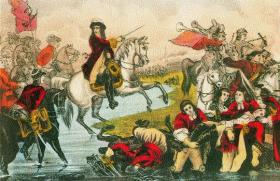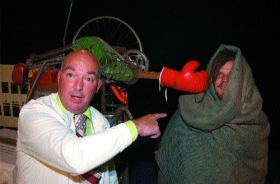‘You thought you knew . . .’
Published in Issue 2 (Summer 2004), Reviews, Volume 12BBC Northern Ireland
King Billy (Olivia Nash), 28 January
The Plantation (Jimmy McAleavy), 4 February
St Patrick (Ian Kirk-Smith), 11 February
by Eamon O’Flaherty
 ‘You thought you knew . . .’ is an engaging title for a short series of history programmes on BBC that went directly to the heart of some of the most potent symbols in Ulster’s collective memory. In the tenth year of the current Peace Process, it is a challenge to programme-makers to produce films on these most controversial of topics that are neither bland nor exclusive. Parity of esteem and mutual understanding through history may be a tall order, but a good balance was struck here. Though a team effort, the whole thing was held together by the amiable presenter, Jim McDowell, who managed to combine first-person credibility with an ability to present often-complex historical arguments in an enviably clear and engaging manner. The producers also managed to achieve a standard approach across the three subjects.
‘You thought you knew . . .’ is an engaging title for a short series of history programmes on BBC that went directly to the heart of some of the most potent symbols in Ulster’s collective memory. In the tenth year of the current Peace Process, it is a challenge to programme-makers to produce films on these most controversial of topics that are neither bland nor exclusive. Parity of esteem and mutual understanding through history may be a tall order, but a good balance was struck here. Though a team effort, the whole thing was held together by the amiable presenter, Jim McDowell, who managed to combine first-person credibility with an ability to present often-complex historical arguments in an enviably clear and engaging manner. The producers also managed to achieve a standard approach across the three subjects.
The way in which Irish people ‘own’ Patrick and William illustrates how living history and legend are often at odds with academic history. Now even historians are aware of the ways in which our historical memory is an admixture of popular culture, public orthodoxy and academic history. In Irish terms, Patrick is an object lesson in just how an original historical fact acquires layers of value and meaning in the course of time. In a beautifully modulated intervention, Ian Paisley conveyed his sense of Patrick as a historical figure (‘a real man’) and his own belief that Patrick, were he alive today, would buttonhole the presenter to preach the gospel in Donegall Square. The same point was made by a succession of archaeologists and historians: the historical Patrick is also the legendary figure who has been invoked in different ways across the intervening centuries—right down to his presence at the centre of an evolving tradition of street theatre from Belfast to New York. Patrick now represents both Irishness and Christianity in Ireland (‘from Paisley to Purgatory and back’), which are contested ideas. But historians like Thomas O’Loughlin and Tim Campbell gave us some reassurance by showing that Patrick’s legacy was always contested by the powerful forces seeking to dominate Ulster and Ireland—such as the Uí Néill in the seventh century and the Normans in the twelfth and thirteenth centuries. Is Patrick now available as the apostle of the Peace Process?

St Patrick. (Currier and Ives)
Olivia Nash’s William of Orange is both more approachable and more aloof. Jim McDowell went on a tour of desirable places in this film—The Hague, Brixham, Hampton Court, Kensington Palace, Whitehall and the Boyne water—yet never quite lost sight of the fact that the legend of King Billy is every bit as powerful as William of Orange’s place in official history. Unlike Patrick, William has only had 300 years in which to become a legend. In fact, to test the legend we compare it to the vast amount we know about the historical William. This is an old game, but was rather well done here. Maureen Waller and Dutch historian Wout Troost showed just how marginal Ireland was to William’s role in organising the European coalition against Louis XIV. European power politics mattered more than religion. Although he was a Protestant hero, William was not the architect of the penal laws against Catholics and Presbyterians in eighteenth-century Ireland. But the film was not stuck in this groove. Gordon Lucy and Richard Doherty gave us the sense of the enduring reality of the Williamite legend, and the film brought home to us how deeply rooted this legend remains in the consciousness of Ulster people.
Jimmy McAleavy’s film on the Ulster Plantation, which possessed a central figure in Hugh O’Neill, shared the strengths of the series and its focus on the interaction of history and collective memory. The main difference with the Plantation is that it has been used to define the origins of the whole community as Planter or Gael and, as was pointed out, has sustained competing legends. Once again we had an exercise in demythologising. Gaelic Ulster was not a prelapsarian state; O’Neill was an astute politician with a foot in both worlds; Catholics formed an important proportion of the stakeholders. Another important register, as in other films, was the degree to which our local legends are part of wider historical power structures. Thus the role of England and English interests looms large in the account of the fall of O’Neill and the new policy of plantation—one area neglected in the series. In the treatment of William and even the Plantation there was very little mention of Scotland and lots about England. A viewer might have come away with the impression that Scotland and the Scots have played a relatively minor role in these great historical moments.
Finally, this series was well made and entertaining without ‘dumbing down’. The programmes would probably also provide very useful backup to second-level Irish history teaching, North and South.

Presenter Jim McDowell managed to combine first-person credibility with an ability to present often-complex historical arguments in an enviably clear and engaging manner. (BBC Northern Ireland)
Eamon O’Flaherty lectures in history at University College Dublin.
















